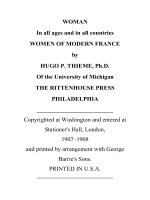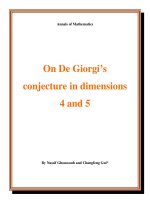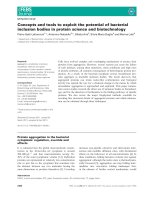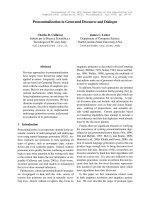LATE ANTIQUE SCULPTURE IN EGYPT: ORIGINALS AND FORGERIES pdf
Bạn đang xem bản rút gọn của tài liệu. Xem và tải ngay bản đầy đủ của tài liệu tại đây (2.12 MB, 9 trang )
ONLINE PUBLICATIONS: MUSEUM REVIEW
AJA
Issue 114.2 (April 2010)
American Journal of Archaeology Online Museum Review
Copyright © 2010 by the Archaeological Institute of America
Late Antique Sculpture in Egypt:
Originals and Forgeries
By Alexander V. Kruglov*
UNEARTHING THE TRUTH: EGYPT’S PAGAN AND
COPTIC SCULPTURE, BROOKLYN MUSEUM, 13
FEBRUARY–10 MAY 2009, curated by Edna R.
Russmann.
UNEARTHING THE TRUTH: EGYPT’S PAGAN AND
COPTIC SCULPTURE, by Edna R. Russmann.
Pp. 91, color figs. 44. Brooklyn Museum,
New York 2009. $19.95. ISBN 978-0-87273-
162-2 (cloth).
The Brooklyn Museum, which houses one
of the most extensive Coptic art collections in
the United States, has a long-established tradi-
tion of presenting Egypt’s pagan and Coptic
art to the public. Some of Brooklyn’s Coptic
sculptures that had at first been acclaimed and
published later proved not to be authentic,
including several of the most famous pieces.
Thus, the question of authenticity is a special
emphasis of the exhibition Unearthing the Truth,
which displays Egyptian works from the third
to the eighth centuries C.E.
The turn of the millennium was marked by
special interest in the history of Christianity,
and a range of exhibitions were dedicated to
Byzantine art; some included Coptic objects,
others were devoted exclusively to Coptic
art—the Christian art of Late Antique Egypt.
Christians and pagans lived side by side in the
complex ethnic society of Egypt at this time.
Since the Egyptian culture of these early cen-
turies C.E. had absorbed the legacies of ancient
Egyptians, Hellenistic Greeks, and Romans,
many pagan images and ideas were inherited
by Christian patrons and artists. In addition,
several of the icongraphic schemes and types
of reliefs employed were similar to or even bor-
rowed from Byzantine art. Both the Brooklyn
Museum’s exhibition and its catalogue, how-
ever, wish to remove Late Antique Egyptian
material from the Byzantine sphere,
1
and to this
reviewer that approach seems problematic.
Many museums, especially older ones, have
obtained forgeries in the course of building
their collections, and this brings to the fore
the interesting issue of why forgeries were ac-
cepted by art historians at the time of acquisi-
tion. Recognizing contemporary forgeries, of
course, often requires the passage of time, and,
as a result, a portion of a museum’s storage can
end up being devoted to fakes. In most cases,
curators are aware of the forgeries in their col-
lections. There is generally little need for public
declaration of the presence of these fakes by
means of display in museums because they
have often been published. A special publica-
tion of the Coptic sculpture forgeries in the
Brooklyn Museum appeared in 2001.
2
Yet the
opportunity to view fakes is always of interest
to museum visitors.
The present exhibition has been conceived
as a small-scale, in-house show that offers 31
limestone sculptures displayed in two small
galleries and a third large one (fig. 1). Contrast
of authenticity has been chosen as the organiz-
ing principle of the installation design; black
*
I would like to dedicate this review to the memory
of my father, whose death delayed its completion.
Special thanks go to Museum Review Editor Beth
Cohen for her suggestions and her help with the
revision, Edna R. Russmann for visiting the exhibition
with me, and Mark Santangelo, of the Onassis Library
for Hellenic and Roman Art at the Metropolitan
Museum, for his assistance.
1
Russmann 2009, 13.
2
Spanel 2001.
American Journal of Archaeology Online Museum Review
2
walls and Plexiglas vitrines with black bases
indicate sculptures accepted by the museum as
authentic, while white walls and white vitrine
bases set off recognized forgeries. The objects
themselves are brightly lit by ceiling spotlights
in otherwise dark galleries, thus creating a
dramatic effect and an aura of mystery.
Despite the exhibition’s clever organization-
al concept, the design also causes difficulties
for the visitor. Some labels or parts of labels are
illegible because they merge into the darkness,
and some labels are written on posts, making
them difficult to find. Moreover, labels for
objects displayed in different cases tend to be
grouped on one case only, and the viewer has to
search for them. Another serious problem with
the display is the way some objects have been
installed. In contradistinction to their original
disposition of generally being attached to or
inserted into walls, the stone slabs in the exhibi-
tion, with few exceptions, are layed down hori-
zontally inside the cases. Furthermore, many of
the cases are low, forcing most visitors to bend
over or even crouch down in order to look at
the objects closely. Mounting the heavy stones
vertically would have required a considerable
effort, employing technical procedures and
devices that the Brooklyn Museum has chosen
to avoid completely. Brooklyn’s decision fares
poorly in comparison with the fine presentation
of similar material at the Metropolitan Museum
of Art or the Louvre, for example, where slabs
are either positioned vertically or fixed against
the wall at a height approximating their origi-
nal architectural placement.
The exhibition’s first gallery, featuring a
map of Egypt in late antiquity and an accom-
panying introductory wall text, displays only
a single object: the funerary relief of C. Julius
Valerius from the third century C.E. The most
ancient work in the show,
3
it belongs to the
period of Roman rule in ancient Egypt and
displays both pharaonic and Roman features.
This combination, which reveals the interac-
tion of two pagan cultures and their religious
beliefs, laid the artistic foundation for later
Christian art in Egypt. Charles Edwin Wilbour
(1836–1896), the American Egyptologist who
spent several years in Egypt studying ancient
monuments with hieroglyphic inscriptions and
forming his collection, acquired this funerary
relief in Cairo on 6 November 1881. In 1916,
3
Inv. no. 16.105 (Russmann 2009, 20–1, no. 1).
Fig. 1. Installation view of the large exhibition gallery (© Brooklyn Museum).
American Journal of Archaeology Online Museum Review
3
after his death and that of his wife, their family
gave Wilbour’s library and collection of more
than 2,000 items to the Brooklyn Museum and
later established the Wilbour Fund, which has
financed many acqusitions. Indeed, according
to their labels, most of the items in the pres-
ent exhibition, as well as in the display of the
permanent collection of ancient Egyptian art
at the museum, are either gifts of the Wilbour
estate or purchases of the Wilbour Fund. It
would therefore be appropriate for both the
exhibition’s didactic material and its catalogue
to include a note on the history of the collection
and perhaps a photograph of Wilbour.
The exhibition’s second, and main, gallery
continues the display of funerary stelae. Late
Antique sculpture generally took the form of
tomb elements, such as stelae, niche heads
(the upper part of arched niches), relief friezes
(including door and arch frames), and column
capitals. Contemporaneous church decoration
would have employed nearly the same types
of reliefs. Thus, in late antiquity, the artistic
choices became limited.
The Stele of Olympios (ca. 500–600 C.E.),
which clearly belongs to a Christian grave,
presents both traditional and new features.
4
It shows a young man framed by two spiral
columns with papyrus capitals supporting a
gable; the architectural framework serves as a
sanctuary for the deceased, who, according to
the inscription, died at the age of 28. This relief
demonstrates how the late pagan iconographic
tradition survived. The depiction of youth is
a remnant of a pagan custom, as is the young
man’s nakedness, evoking classical heroic nu-
dity. Finally, while his pose, with arms raised
toward the crown on his head, recalls the pagan
context of the athletic victor, this motif should
be understood as indicating that the deceased
will be awarded eternal afterlife. Olympios’
crown is obviously a funerary, rather than a
victory, wreath; it appears to represent a wreath
of gold-foil laurel leaves with a central jewel or
precious coin. Furthermore, both of Olympios’
arms are raised like those of an orans (a figure
in the attitude of early Christian prayer), and
a looped cross, identical in shape to the ankh
(the ancient Egyptian symbol for life), appears
on the right side of the stele.
The C. Julius Valerius and Olympios stelae
represent vividly the contrasting artistic ap-
proaches in rendering the human form char-
acteristic of two different historical periods.
The first still displays qualities inherited from
Hellenistic Greek and Roman art, such as the
treatment of plastic volumes and details of
anatomy and proportions. The second demon-
strates a new mode of expressiveness achieved
by introducing anatomical disproportion and
a flat form of relief, whose details are sharply
outlined or incised.
The first grouping of objects in the main
gallery also includes three stelae associated
with pagan graves at Oxyrhynchus. About 650
pieces of architectural reliefs have been found
at this site,
5
which was once a provincial capital
and was also certainly an important center for
sculpture with its own workshops.
6
However,
many pieces were not excavated by archaeolo-
gists, and they passed through the antiquities
market, where they were massively recut or re-
painted.
7
This material introduces the sensitive
issue of how one ought to define and perceive
forgeries. In the 1970s, German scholars started
to use the designation verfälschte Stücke (faked
works) in contradistinction to absolute fakes;
they reserved the term for ancient but severely
recarved and repainted pieces
8
and also sug-
gested that such objects should be excluded by
scholars from the circle of authentic works.
9
Pieces in the Brooklyn Museum from Oxy-
rhynchus have been reworked to different
degrees. A large stele portrays a woman of high
social rank, who was probably a priestess of
Isis.
10
This stele is executed in such high relief
4
Inv. no. 40.301 (Russmann 2009, 26–7, no. 4). The
curator believes that this Christian monument was re-
cut from a pagan one; however, her assumption that
the left side of the stele was cut back does not seem to
be correct. The column on the left side is indeed thin-
ner, but it has the same capital with two leaves, in-
dicating that nothing is missing from its design. The
cross was not added later because the undercutting
around it is similar to the carving of the eyebrows and
nipple of the human figure.
5
Krumeich 2003; Schmidt 2003, 62–75.
6
Thomas (1989, 1:155–82) argues about individu-
al artisan’s practice, supported by references to con-
struction contracts preserved among the papyri.
Török (2005, 201–11) insists on the presence of work-
shops. There is no reason to question the two different
practices: individuals were employed for small-scale
work (e.g., private tombs), and workshops were em-
ployed to decorate churches and monasteries.
7
Thomas 1989, 1:127–38, 148–49.
8
Parlaska 1978, 117* (163); Severin 1995.
9
Severin 1999, 365.
10
Inv. no. 70.132 (Russmann 2009, 54–5, no. 18).
American Journal of Archaeology Online Museum Review
4
that it gives the impression of being sculpted in
the round, and this impression is also empha-
sized by its fragmentary state of preservation,
which may be attributed to tomb robbers, who
cut away portions of the thick background
to make the piece lighter. The following two
pieces exhibit even more extensive reworking
commissioned by modern antiquities dealers.
These are funerary stelae that represent boys,
either standing or kneeling.
11
While painting
on a prepared plaster layer applied over the
porous stone surface is a common feature of
limestone relief sculpture from Late Antique
Egypt, on the stele of the kneeling boy one can
easily observe the contrast of the remains of
original paint on the surrounding arch with the
wholely repainted surfaces of the boy’s face,
his garment, and the cushion. The recarving
and repainting are even more obvious on the
relief depicting a standing boy. Despite the
assertion in the catalogue that on account of
this reworking the piece should be considered
a forgery,
12
it has been exhibited among the
authentic objects in a vitrine with a black base
rather than in the white section containing the
fakes. Surely, the exhibition’s conception and
display ought to have helped visitors distin-
guish clearly reworked objects from authentic
pieces and complete fakes by introducing gray
as a third color-coded category.
Two other stelae, both Christian works from
the seventh to eighth centuries, are remark-
able pieces of ornamental art.
13
The Christian
symbolism of the larger of these two stelae is
emphasized by means of five representations
of the cross and an outer ornamental border of
grapes and a vine issuing from a vessel; in ad-
dition to an allusion to resurrection, which was
also known to pagans in a Dionysiac context,
the vine symbolizes the Christian faith. Another
motif that appears on both of these stelae con-
sists of two columns supporting a shell-shaped
arch; it brings to mind a similar structure in Late
Antique Egyptian architecture—the arched
niche—employed by pagans for their tombs
and by Christians for both sepulchral and
ecclesiastical architecture.
Examples of reliefs designed as niche heads
are exhibited nearby. Sculptures in this section
represent allegorical and mythological subjects,
such as personifications of the Nile River and
the Earth and a nymph riding a sea monster
(fig. 2).
14
When excavations revealed similar
reliefs in the late 19th and early 20th centuries,
the archaeological evidence was incomplete,
making it difficult to decide whether the
context was purely pagan or Christian. The
mythological reliefs were nevertheless believed
to have come from church architecture, and
Christian meaning was applied to them. This
understanding fostered speculations about
the interpretation of pagan motifs in Christian
art. More recent scholarship, however, has es-
tablished that the architectural remains where
such reliefs have been found should instead
be interpreted as pagan funerary chapels and
thus that the mythological reliefs must have
been commissioned by the pagan elite who
still held the ideas of classical culture.
15
The
testimony of inscriptions and epigrams from
Graeco-Roman Egypt also associates allegori-
cal or mythological images with the deceased.
Two epigrams inscribed on the doorway of the
funeral chamber of Isidora of the second cen-
tury C.E., from the necropolis near Hermopolis
Magna, state that the young girl is becoming
a nymph—a form of apotheosis.
16
Including
a quotation from this beautiful poetry on a
text plaque near the nymph relief would have
enabled visitors to learn directly about pagan
beliefs and funerary symbolism.
Niche decoration of this sort is rather un-
usual, thus additional explanatory information
should have been provided for the general pub-
lic. If not sophisticated computer touch screens
with digital reconstructions, then graphic
reconstructions and photographs ought to have
been employed here. The exhibition’s installa-
tion has no didactic material of this kind, and its
absence becomes even more glaring in that the
gallery’s two long, empty walls bear nothing
but inappropriately oversized titles and texts.
Most unfortunately, little or no information
from the museum’s conservators about the
objects is included anywhere in the installa-
tion—not even for pieces believed to be highly
reworked or outright forgeries. And this vital
information does not appear in the catalogue.
11
Inv. nos. 58.129, 71.39.2 (Russmann 2009, 46–7, no.
14; 58–9, no. 20).
12
Russmann 2009, 58.
13
Inv. nos. 69.74.2, 71.39.1 (Russmann 2009, 52–3,
no. 17; 56–7, no. 19).
14
Inv. nos. 41.891, 41.1226 (Russmann 2009, 30–1,
no. 6; 32–3, no. 7).
15
Torp 1969; Török 2005, 31–7, 115–29.
16
Kákosy 1982, 294–95.
American Journal of Archaeology Online Museum Review
5
The visitor thus receives the perhaps mislead-
ing impression that the Brooklyn Museum’s
decisions about authenticity have been made
largely on the basis of art historical connois-
seurship. After careful observation of the works
on display, this reviewer is inclined to add his
own empirical observations as well as certain
queries.
Attentive observation of the supposedly au-
thentic nymph relief (see fig. 2), for example, re-
veals various discrepancies, such as the missing
outer border of the architectural ornament; a
state of preservation in which the carving of the
nymph and sea monster looks fresher than that
of the ornament,
17
which has heavy weathering
and traces of paint; and the unusual iconogra-
phy of a completely dressed nymph. None of
these features is mentioned by the curator. Is
this paint ancient in its chemical composition,
and have traces of paint also been discovered
on the figures themselves? If the figures have
been recarved, then to what extent? And if the
recarving was extensive, should this piece be
considered authentic or faked?
This group of architectural reliefs also
includes a fragmentary frieze with a repre-
sentation of Hercules and a bull (fig. 3).
18
It
seems strange that the authenticity of this
relief has not been questioned, though an at-
tentive eye immediately notices some rather
bizarre features that suggest that the work is
unerhörtes (incredible).
19
The structure of this
frieze’s relief is highly unusual. In authentic
representations, half of an animal normally
emerges from a scroll, and together they form
a unified relief level above the background.
This piece, however, shows three different relief
levels: one close to the background formed by
scrolls, a middle level with the bull, and the
highest level with the figure of Hercules. As a
result, the projecting forefeet of the galloping
bull and left foot of the hero have received
supporting struts. Providing struts for fragile
parts is necessary in the carving of large marble
sculpture in the round but is not necessary for
small limestone reliefs. The projecting strut
for the bull’s feet is especially odd because it
interrupts the vine scrolls, whose composition
would otherwise be continuous. Even if one
were to suggest that this relief had been left
incomplete and that is why struts remain, how
would these figures’ feet look if they had been
finished as completely separate entities project-
17
Thomas (1989, 2:98) has already noted that the
nymph’s mouth and the sea monster’s pelt were re-
carved. Moreover, the tool marks indicating the sea
monster’s eyes and teeth and the nymph’s facial fea-
tures and dress embroidery appear to be the same as
in the recarved areas.
18
Inv. no. 61.128 (Thomas 1989, 1:248–49, esp. n.
281; 2000, 60–1; Russmann 2009, 48–9, no. 15).
19
Severin (1999, 366) introduced the term uner-
hörtes to describe incredible iconography in faked
Coptic sculpture.
Fig. 2. Top of a Late Antique Egyptian limestone arch
with a nymph riding a sea monster, ht. 46 cm, wdth. 80
cm, fifth–sixth century C.E., from Herakleopolis Magna.
New York, Brooklyn Museum, Charles Edwin Wilbour
Fund, inv. no. 41.1226 (© Brooklyn Museum).
Fig. 3. Limestone relief with Hercules and either
Acheloos in the form of a bull or the Cretan Bull, ht.
34 cm, wdth. 37.5 cm, either Late Antique Egyptian,
ca. 300–500 C.E., from Oxyrhynchus, or forgery, 20th
century C.E. New York, Brooklyn Museum, Charles
Edwin Wilbour Fund, inv. no. 61.128 (© Brooklyn
Museum).
American Journal of Archaeology Online Museum Review
6
ing into space? In addition, the scroll does not
continue behind Hercules’ head, and here there
is simply a blank recessed background. None
of the above features occurs in the limestone
carving technique developed by Late Antique
sculptors.
20
Classical iconography, which was adopted
in Late Antique Egyptian sculpture, distin-
guishes clearly between representations of
Hercules with Acheloos vs. the Cretan Bull.
While the museum identifies the bull in this
relief as the river god Acheloos, he is normally
shown either as a bull with a human head or as
entirely human, but never simply as an animal.
Therefore, whether the Brooklyn relief is real or
fake, its bull must be the Cretan Bull.
Late Antique (both pagan and Christian)
architecture in Egypt developed a fashion
of ornamenting the interior or exterior walls
with bands of horizontal or curving reliefs. A
carved limestone arch in five segments is the
central focus of the exhibition’s design (see fig.
1, middleground). Contrary to the curator’s
opinion about the modest size of this arch,
21
the piece actually demonstrates the large scale
that may be employed for architectural ele-
ments. This big arch, installed on a separate
freestanding wall section, helps the visitor
visualize the scale of Egyptian monuments
in this period. Its decorative motif repeats the
same pattern—birds and flowers shown in
mirror images. This arch is unique: it does not
have an exact parallel among extant decorative
architectural reliefs.
The most intriguing part of the show is
the white color-coded section displaying the
revealed forgeries, some of which have not pre-
viously been published. The notorious forged
“Paralytic,” for a considerable time accepted as
a marvel of Coptic sculpture in the round (fig.
4),
22
is clearly related to the forged figure of a
man in high relief.
23
Both probably came from
Sheikh Ibada, the place that appears to have
produced and whose name now designates
an entire group of outright fakes or reworked
sculptures.
24
They might even have been made
in the same workshop because their treatment
of facial features—especially eyes—is very
much alike. Genuine Late Antique Egyptian
sculpture presents a surprising variety of about
10 types of eye modeling. The forgers of the
Sheikh Ibada group appear to have created
their own type of eye, which is outlined by
sharply carved eyelids that contain an enlarged
spherical iris with a drilled pupil, while the rest
of the eyeball is omitted; this eye has no parallel
in authentic sculpture. In addition, faces in this
forged group are well-proportioned, and the
smiles of its figures suggest their psychological
state, features that are otherwise unfamiliar in
Late Antique sculpture from Egypt.
Two reliefs in the next case are betrayed as
fakes by their being carved in porous num-
militic limestone, which was not employed
for ancient reliefs. The relief with three busts
on a capital of leaves has meaningless iconog-
20
Many reliefs represent the feet positioned on the
lower border. When the border is broken or fragmen-
tary, it can look like a console (Strzygowski 1904, 24,
no. 7281; 26, no. 7283).
21
Inv. no. 45.131a–e (Russmann 2009, 37–9, no.
10).
22
Inv. no. 62.44 (Russmann 2009, 68–9, no. 24).
23
Inv. no. 72.9 (Russmann 2009, 78–9, no. 2).
24
Inv. nos. 62.44, 72.9 (Russmann 2009, 68–9, no. 24;
78–9, no. 29). Forgeries from Sheikh Ibada have been
discussed by Boyd and Vikan 1981, 8–9; Thomas 1989,
1:139–49; Spanel 2001, 89–97.
Fig. 4. Painted limestone relief with a paralytic raising
his bed, ht. 61.5 cm, said to be from Sheikh Ibada;
forgery, 20th century C.E. New York, Brooklyn Museum,
Charles Edwin Wilbour Fund, inv. no. 62.44 (© Brooklyn
Museum).
American Journal of Archaeology Online Museum Review
7
raphy,
25
and the relief that is possibly meant to
depict the Holy Family has a very weak compo-
sition.
26
The two arches enclosing the figures in
the Holy Family relief do not form a true frame
because they do not fill the entire surface of the
slab, leaving blank space—a trait that is not
characteristic of genuine reliefs. These two fake
reliefs show yet a different type of eye model-
ing, which consists of a large, slightly elongated
eyeball with a drilled pupil, inserted below an
eyebrow that substitutes for the upper eyelid;
there is no indication of the lower lid. Authentic
sculpture rarely omits eyelids.
Another group of black cases with “authen-
tic” objects is displayed adjacent to the white
area containing works designated as forgeries,
but to this observer some of the accepted pieces
also seem questionable. Defining the typology
and the purpose of sculptures is very important
for detecting forgeries. Much attention has been
drawn to the fact that many Christian subjects
not known in genuine Coptic sculpture appear
in the forgeries. Is Brooklyn’s “Bust of a Saint”
relief, dated from the fourth to fifth century
C.E., genuine?
27
The saint has wide-open eyes
with sharply carved lids and large spheres
representing the irises instead of full eyeballs,
a nose that is exceptionally thin and elongated,
somewhat smiling lips, and an unusually ren-
dered beard. All these details have parallels in
the above-mentioned forgeries. Once again,
there is no overall homogeneity; the head of the
saint is too three-dimensional compared with
the shallow relief of the rest. Significantly, while
the Bust of a Saint (though it lacks a frame)
resembles the fragmentary stele representing a
monk standing in an orans pose,
28
there are no
other orans bust compositions in Coptic reliefs.
Nonetheless, as demonstrated by its thin lower
border, this piece was evidently conceived as
a bust.
Over time, the Coptic church excluded
figurative sculpture from ecclesiastical interi-
ors, which came to be decorated exclusively
with frescoes and painted icons. Thus, it is
not entirely clear how some early reliefs with
Christian subjects originally might have been
employed. This is the case for the two famous
reliefs depicting the martyrs St. Thekla and St.
Sissinios (fig. 5), displayed in black cases in this
area.
29
Previous studies have not noted that
these reliefs have been left unfinished. This lack
of finish is evident from visible tool marks of
the tooth chisel used for basic shaping in stone-
work. These marks appear nearly everywhere
on the Thekla relief and on part of the border of
the Sissinios relief. The unfinished state of the
last relief is also suggested by the presence of
an undeveloped mass of stone behind Sissinios’
head and elbow, which was once thought to be
an animal’s skull.
30
Looking carefully at this
relief reveals that the surfaces of its figures were
evidently reworked in modern times until they
became smooth with roundish outlines. But
traces of paint on the surface of both reliefs
were discovered decades ago,
31
and this makes
the situation even more puzzling. Were these
unfinished reliefs accepted as complete at the
time they were made and thus painted, or did
a new style, a Coptic non finito, develop?
32
Once
again, one regrets the absence of conservators’
observations that could enhance the visitors’
understanding of the objects.
The exhibition’s final, small gallery, devoted
to authentic works recut in the 20th century,
bears the title “True or False?” Although re-
worked objects have already appeared in the
main gallery, they have not been distinguished
by color throughout the exhibition. This final
gallery highlights material with atypical ico-
nography. Without additional comparative
pieces in an analogous style and technique, it
is difficult to explain the peculiarities of two
reliefs displayed here, which are said by the
Brooklyn Museum to be recarved: the “Plant
Scroll with Human Figure” and the “Plant
Scroll with Snakes and Bird Heads.”
33
A small catalogue published on the occasion
of the exhibition does not organize the entries
for the individual objects according to the in-
stallation; instead, within chapters devoted to
authentic Late Antique works and “Evocations
of Late Antique Sculpture,” they are listed in
numerical order according to their accession
25
Inv. no. 72.10 (Russmann 2009, 80–1, no. 30).
26
Inv. no. 77.129 (Russmann 2009, 82–3, no. 31).
27
Inv. no. 55.2.3 (Russmann 2009, 44–5, no. 13).
28
Cf. the reliefs in Dumbarton Oaks Research Li-
brary and Collection and the British Museum (Vikan
1995, 55–6, figs. 21–21.I).
29
Inv. nos. 40.299, 40.300 (Russmann 2009, 22–5,
nos. 2, 3).
30
Nauert and Warns 1981, 70.
31
Cooney 1944, 38.
32
Archaeologists have observed sculptural blocks
employed without final finishing (Grossman and
Bailey 1994, 56).
33
Inv. nos. 67.176.2, 68.3 (Russmann 2009, 72–5,
nos. 26, 27).
American Journal of Archaeology Online Museum Review
8
numbers.
34
The catalogue provides the reader
with brief descriptions and thematic consid-
erations and a short, selected bibliography. Its
color photographs, including enlargements of
fragments, are helpful for studying the sculp-
tures. Unfortunately, this slender volume does
not include detailed information about the his-
tory of the Late Antique collection, the possible
findspots of objects or else their purchase on
the art market, a discussion of how and where
the fakes were made, or, most importantly,
results of the conservators’ examination of
the objects—all topics that the chosen subject
requires.
With this exhibition, the Brooklyn Museum
provides an important selection of objects that
are not otherwise on display. It will surely
prompt further discussion by scholars, and it is
also of interest to members of the general public
eager to learn more about art forgery. At the end
of the last gallery, one may enter comments at a
computer terminal that are then displayed on
the museum’s Web site for the exhibition. Visi-
tors’ comments reveal their excitement about
and involvement with questions concerning
the authenticity of sculpture from Late Antique
Egypt. The curator’s focus is on forgeries from
the 1950s to 1970s, but doubts about authentic-
ity ought also to extend to objects acquired
earlier.
35
Since the late 19th century, scholars
and archaeologists acquired Coptic antiquities
on behalf of European and American museums,
and the market reacted to growing demand.
When Wilbour traveled to the pyramids at
Giza in 1881, he could not miss seeing “a flock
of vendors of false antiquities.”
36
435 FORT WASHINGTON AVENUE, APT. 3E
NEW YORK, NEW YORK 10333
Works Cited
Boyd, S., and G. Vikan. 1981. Questions of Authentic-
ity Among the Arts of Byzantium: Catalogue of an
Exhibition Held at Dumbarton Oaks, January 7–May
11, 1981. Washington, D.C.: Dumbarton Oaks and
Trustees for Harvard University.
Cooney, J.D. 1944. “Problems of Coptic Art.” In
Coptic Art: Papers Read at a Symposium Held Under
the Joint Auspices of New York University and the
Brooklyn Museum, February 15, 1941, in Connection
Fig. 5. Late Antique Egyptian limestone relief with St. Sissinios, perhaps with modern reworking,
ht. 38.8 cm, wdth. 58 cm, sixth century C.E. New York, Brooklyn Museum, Charles Edwin Wilbour
Fund, inv. no. 40.300 (© Brooklyn Museum).
34
Russmann 2009.
35
At least four reworked pieces were acquired in
1940 or 1941: inv. nos. 40.299, 40.300, 40.302, 41.1226
(Russmann 2009, 22–5, 28–9, 32–3, nos. 2, 3, 5, 7).
36
Wilbour 1936, 11, 77, 146.
American Journal of Archaeology Online Museum Review
9
with the Exhibition “Paganism and Christianity in
Egypt,” Shown at the Brooklyn Museum, January
23 to March 9, 1941, 35–41. Brooklyn: Brooklyn
Museum Press.
Grossmann, P., and D.M. Bailey. 1994. “The South
Church at Hermopolis Magna (Ashmunein): A
Preliminary Report.” In Churches Built in Ancient
Times: Recent Studies in Early Christian Archaeology,
edited by K. Painter, 49–71. London: Society of
Antiquaries of London and Accordia Research
Centre, University of London.
Kákosy, L. 1982. “The Nile, Euthenia, and the
Nymphs.” JEA 68:290–98.
Krumeich, K. 2003. Spätantike Bauskulptur aus Oxy-
rhynchos: Lokale Produktion–äussere Einflüsse. 2
vols. Wiesbaden: Reichert.
Nauert, C., and R. Warns. 1981. Thekla: Inhre Bilder
in der frühchristlichen Kunst. Göttinger Orientfor-
schungen 2. Wiesbaden: Harrassowitz.
Parlaska, K. 1978. “Der Übergang von der spätrö-
mischen zur frükoptischen Kunst im Lichte
der Grabreliefs von Oxyrhynchos.” Enchoria:
Zeitschrift für Demotistik und Koptologie 8 (Son-
derband):115* (161)–120* (166).
Schmidt, S. 2003. Grabreliefs im Griechisch-Römischen
Museum von Alexandria. Berlin: Achet-Verlag.
Severin, H G. 1995. “Pseudoprotokoptika.” In Divi-
tiae Aegypti: Koptologische und verwandte Studien
zu Ehren von Martin Krause, edited by C. Fluck,
L. Langerer, S. Richter, S. Schaten, and G. Wurst,
289–99. Wiesbaden: Reichert.
———. 1999. “Anmerkungen zur Rezeption kop-
tischer Skulptur in Koptischen Museum.” In
Ägypten und Nubien in spätantiker und christlicher
Zeit: Akten des 6. Internationalen Koptologenkon-
gresses, Münster, 20.–26. Juli 1996, edited by S.
Emmel, 365–74. Wiesbaden: Reichert.
Spanel, D. 2001. “Two Groups of ‘Coptic’ Sculpture
and Relief in the Brooklyn Museum of Art.”
JARCE 38:89–113.
Strzygowski, J. 1904. Koptische Kunst. Vienna: Hol-
zhausen.
Thomas, T.K. 1989. “Niche Decorations from the
Tombs of Byzantine Egypt (Heracleopolis Magna
and Oxyrhynchus, A.D. 300–500): Visions of
the Afterlife.” 3 vols. Ph.D. diss., New York
University.
———. 2000. Late Antique Egyptian Funerary Sculp-
ture: Images for This World and the Next. Princeton:
Princeton University Press.
Török, L. 2005. Transfigurations of Hellenism: Aspects
of Late Antique Art in Egypt, AD 250–700. Leiden:
Brill.
Torp, H. 1969. “Leda Christiana: The Problem of the
Interpretation of Coptic Sculpture with Mytho-
logical Motifs.” ActaAArtHist 4:101–12.
Vikan, G. 1995. Catalogue of the Sculpture in the
Dumbarton Oaks Collection from the Ptolemaic Period
to the Renaissance. Washington, D.C.: Dumbarton
Oaks Research Library and Collection.
Wilbour, C.E. 1936. Travels in Egypt, December 1880 to
May 1891: Letters of Charles Edwin Wilbour. Edited
by J. Capart. Brooklyn: The Brooklyn Museum.









